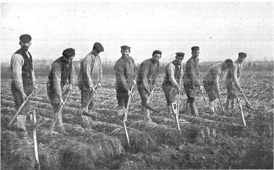I went to visit the fields in Brabant where Rubia tinctorum has been cultivated since the 14th century, when it was brought to Europe from Asia by Karel The Great. In fact, it had the name of being the best crop available throughout the 18th century (E. Bancroft). There is something very profound about reviewing your cultural past, and fitting it into the picture of your current self. I keep looking for the clues that could explain why I just threw myself at textile dyeing at the age of 39 and decided to make a living out of it.

When grain prices went down around 1660, the madder crops became a lucrative, albeit risky, alternative.
Planting and harvesting are pretty labour-intense which provided for a lot of work for men, women and children from the area and surrounding parts as far away as Flanders. Day workers, often single young men, would go in groups from field to field to do the back-breaking work of planting the tiny madder shoots called ‘mee’ or ‘meekrap’ in the lush, clay-rich soil, and pulling them out after three years using special tools to dislocate the 70cm long roots from the clay. The plant parts themselves would be used to feed the cows, who would give pink and yellow tinted milk from it.
Trials to grow the crop in the more central and Northern parts of the Netherlands were a failure.
Back in the days, the roots were processed in the Meestoof (lit. madder oven, processing mill or kiln) after the madder harvest. Due to the high investment costs, a group of farmers, usually sixteen, would jointly own a processing mill. An early form of an agricultural cooperative, if you will. In many villages there was at least one Meestoof, by 1819 there were 90 Meestoven in the Netherlands.
In the Meestoof, the roots were cleaned and stored, dried, threshed, mashed and milled into madder powder or racine powder and then packed in oak barrels.
The book of Philip Miller, written in 1758, called; “The method of cultivating madder, as it is now practised by the Dutch in Zealand: (where the best madder is produced) with their manner of drying, stamping, and manufacturing”, explains in detail the different steps in creating the dye from the roots with illustrations.

The first part of the Meestoof consisted of the cold storage. In this barn every participating farmer had his own storage space where the roots were dumped. From there is was moved to the drying tower. There were four floors in the drying tower, and a low fire was lit at the bottom of the tower. The madder roots started the drying process in the upper attic. They were moved to a floor below for three days. On this lower floor, workers threshed the madder with flails on a large wooden threshing floor. Dust and other iniquities were sieved from the broken roots and the short ends of the roots (racines) were put in barrels.

The rest of the broken madder was spread on a rug on top of the ‘eest’ or ‘ast’ (a narrow, meter-long horizontal oven) and dried. The madder was then mashed or powdered in the ‘stamphuis’. The characteristic draft horses of the southern Netherlands powered the mill (until today there are buildings called ‘rosmolen’, horse mill). After being ground, the powder was sieved.
There were three qualities of end product; the finest powder was clear light yellow, this was the most expensive. The dark red powder was the cheapest.

Specialists would grade the madder (keur) and the barrels would be taken by horse and carriage to a special market in Rotterdam for madder powder. From there the powder was sold to wool dyers and calico printing (about which I will write in the next blog) companies, often in Great Britain, since the French had their own locally produced ‘garance’.
After the discovery of the production of synthetic alizarine in 1870, the madder crop came in swift decline, disappearing about as soon as it had come up 200 years before. The Meestoof became shrimp factories, or storage for other crops (chirochei, a coffee replacement), before most of them were demolished. Nowadays you can still see just a few of these historical buildings in the Netherlands, and what is mostly left of the madder culture is hidden in street names such as Stoofweg, Stoofhoek, Stoofhof and family names; Poerstamper, van Ast, van der Est, van der Mee.

Modern madder farming is still being done on a small scale. Madder prices are attractive for the farmers (about as much as sugar beets, considered a safe and economic crop) and the use of modern machinery has made it easy to plant and harvest. The madder plant does not need pesticides and enriches the soil it grows in, which makes it perfect in crop rotation. Local farmers are investing in improving the quality of the seeds, and farming practices which should improve the yield of the crop per square meter with about 30% in the upcoming years.
I finished my trip with a visit to the biggest and only powder extraction factory and laboratory in the Netherlands that can work with dye plants. Research in new and improved ways of extracting the alizarine from the roots, could increase the strength of the powdered extract such, that it will take only 2% of extract to get amazing deep reds on any fibre. I have no doubt that the surge in interest for natural dyes will soon lead to a renewed increase in madder cultivation in the lush clay fields of Zealand, bringing back the fame of old.
Want to dye with madder? Find the best historical and modern recipes here. Madder extract can be found here, and raw madder powder here.
Images used with permission; https://www.europeana.eu/portal/nl/



